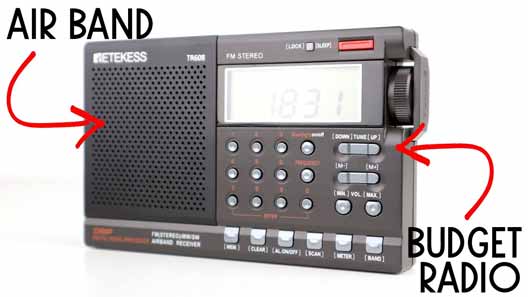Products Category
- FM Transmitter
- 0-50w 50w-1000w 2kw-10kw 10kw+
- TV Transmitter
- 0-50w 50-1kw 2kw-10kw
- FM Antenna
- TV Antenna
- Antenna Accessory
- Cable Connector Power Splitter Dummy Load
- RF Transistor
- Power Supply
- Audio Equipments
- DTV Front End Equipment
- Link System
- STL system Microwave Link system
- FM Radio
- Power Meter
- Other Products
- Special for Coronavirus
Products Tags
Fmuser Sites
- es.fmuser.net
- it.fmuser.net
- fr.fmuser.net
- de.fmuser.net
- af.fmuser.net ->Afrikaans
- sq.fmuser.net ->Albanian
- ar.fmuser.net ->Arabic
- hy.fmuser.net ->Armenian
- az.fmuser.net ->Azerbaijani
- eu.fmuser.net ->Basque
- be.fmuser.net ->Belarusian
- bg.fmuser.net ->Bulgarian
- ca.fmuser.net ->Catalan
- zh-CN.fmuser.net ->Chinese (Simplified)
- zh-TW.fmuser.net ->Chinese (Traditional)
- hr.fmuser.net ->Croatian
- cs.fmuser.net ->Czech
- da.fmuser.net ->Danish
- nl.fmuser.net ->Dutch
- et.fmuser.net ->Estonian
- tl.fmuser.net ->Filipino
- fi.fmuser.net ->Finnish
- fr.fmuser.net ->French
- gl.fmuser.net ->Galician
- ka.fmuser.net ->Georgian
- de.fmuser.net ->German
- el.fmuser.net ->Greek
- ht.fmuser.net ->Haitian Creole
- iw.fmuser.net ->Hebrew
- hi.fmuser.net ->Hindi
- hu.fmuser.net ->Hungarian
- is.fmuser.net ->Icelandic
- id.fmuser.net ->Indonesian
- ga.fmuser.net ->Irish
- it.fmuser.net ->Italian
- ja.fmuser.net ->Japanese
- ko.fmuser.net ->Korean
- lv.fmuser.net ->Latvian
- lt.fmuser.net ->Lithuanian
- mk.fmuser.net ->Macedonian
- ms.fmuser.net ->Malay
- mt.fmuser.net ->Maltese
- no.fmuser.net ->Norwegian
- fa.fmuser.net ->Persian
- pl.fmuser.net ->Polish
- pt.fmuser.net ->Portuguese
- ro.fmuser.net ->Romanian
- ru.fmuser.net ->Russian
- sr.fmuser.net ->Serbian
- sk.fmuser.net ->Slovak
- sl.fmuser.net ->Slovenian
- es.fmuser.net ->Spanish
- sw.fmuser.net ->Swahili
- sv.fmuser.net ->Swedish
- th.fmuser.net ->Thai
- tr.fmuser.net ->Turkish
- uk.fmuser.net ->Ukrainian
- ur.fmuser.net ->Urdu
- vi.fmuser.net ->Vietnamese
- cy.fmuser.net ->Welsh
- yi.fmuser.net ->Yiddish
Know RF Better: The Advantages and disadvantages of AM, FM, and Radio Wave
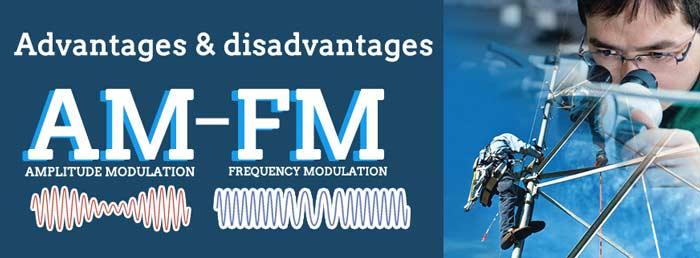

"What are the advantages and disadvantages of AM and FM? This article will use the most common and easy-to-understand language and give you a detailed introduction to the advantages and disadvantages of AM (Amplitude Modulation), FM (Frequency Modulation), and radio wave, and help you better learn RF technology"
As two types of coding, AM (AKA: amplitude modulation) and FM (AKA: frequency modulation) have their own advantages and disadvantages due to their different modulation methods. Many people often ask FMUSER for such questions
- What is the difference between AM and FM radio?
- What does AM and FM stand for?
- What does AM and FM mean?
- What is AM and FM?
- AM and FM meaning is?
- What are AM and FM radio waves?
- What is the advantages of AM and FM
- What is the advantages of AM radio and FM radio
etc...
If you're facing these problems like most people do, well, you're in the right place then, FMUSER will help you better understand these RF technologies theory from "What are they" and "What are the differences between them".
FMUSER often says that if you want to understand the theory of broadcasting, you must first find out what am and FM are! What is AM? What is FM? What is the difference between AM and FM? Only by understanding these basic knowledge can you understand RF technologies theory better!
Welcome to share this post if it is helpful to you!
1. What is Modulation and Why Do We Need Modulation?
1) What is Modulation?
2) Types of Modulation
3) Types of Signals in Modulation
4) Need of modulation
2. What is Amplitude Modulation?
1) Types of Amplitude Modulation
2) Applications of Amplitude Modulation
3. What is Frequency Modulation?
1) Types of Frequency Modulation
2) Applications of Frequency Modulation
4. What are the Advantages and Disadvantages of Amplitude Modulation?
1) The Advantages of Amplitude Modulation (AM)
2) The disadvantages of Amplitude Modulation (AM)
5. Which is better: Amplitude Modulation or Frequency Modulation?
1) What are the Advantages and Disadvantages of FM over AM?
2) What are the Disadvantages of FM?
6. Which is better: AM Radio or FM Radio?
1) What are the Advantages and Disadvantages of AM Radio and FM Radio?
2) What Are Radio Waves?
3) Types of Radio Waves and Their Advantages and Disadvantages
7. Frequently Ask Question on RF Technology
1. What is Modulation and Why Do We Need Modulation?
1) What is Modulation?
Transmission of information by communication systems over large distances is quite a feat of human ingenuity. We can talk, video chat and text anyone on this planet! The communication system uses a very clever technique called Modulation to increase the reach of the signals. Two signals are involved in this process.
Modulation is
- the process of mixing a low energy message signal with the high energy carrier signal to produce a new high energy signal which carries information to a long distance.
- the process of changing the characteristics (amplitude, frequency or phase) of the carrier signal, in accordance with the amplitude of the message signal.
A device that performs modulation is called modulator.
2) Types of Modulation
There are mainly two types of modulation, and they are: Analog Modulation and Digital Modulation.
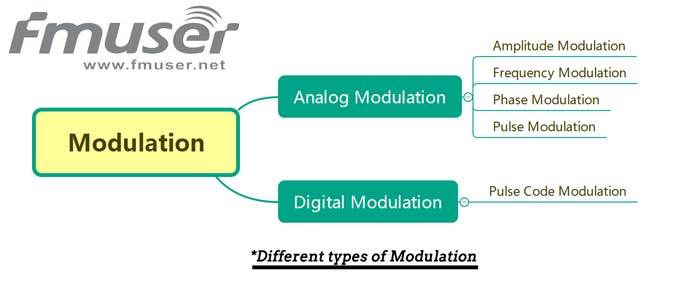
In order to help make you better understand these types of modulation, FMUSER has listed what you need about modulation in the following chart, including the types of modulation, the branch names of the modulation as well as the definition of each one of them.
|
Modulation: types, names and definition |
|||
|
Types |
Sample graph |
Name | Definition |
|
Analog modulation |
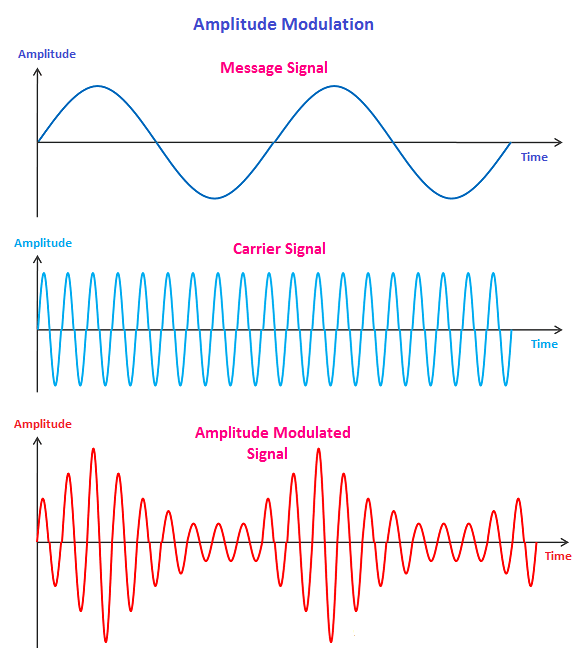 |
Amplitude modulation |
Amplitude modulation is a type of modulation where the amplitude of the carrier signal is varied (changed) in accordance with the amplitude of the message signal while the frequency and phase of carrier signal remain constant. |
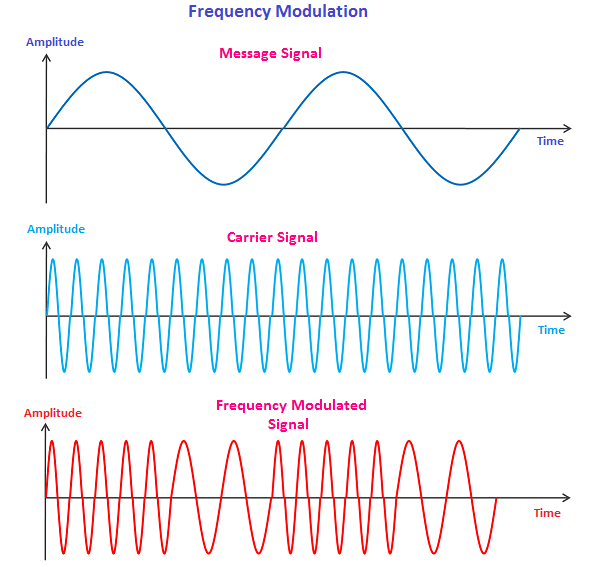 |
Frequency modulation |
Frequency modulation is a type of modulation where the frequency of the carrier signal is varied (changed) in accordance with the amplitude of the message signal while the amplitude and phase of carrier signal remain constant. |
|
 |
Pulse modulation |
Analog pulse modulation is the process of changing the characteristics (pulse amplitude, pulse width or pulse position) of the carrier pulse, in accordance withthe amplitude of the message signal. |
|
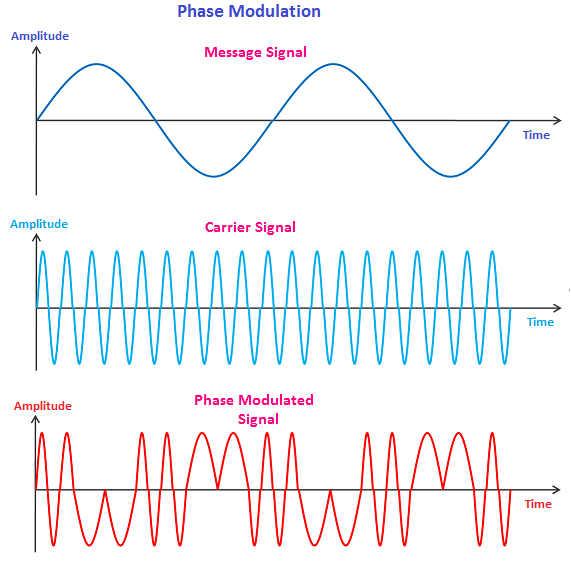 |
Phase modulation |
Phase modulation is a type of modulation where the phase of the carrier signal is varied (changed) in accordance with the amplitude of the message signal while the amplitude of carrier signal remains constant. |
|
|
Digital modulation |
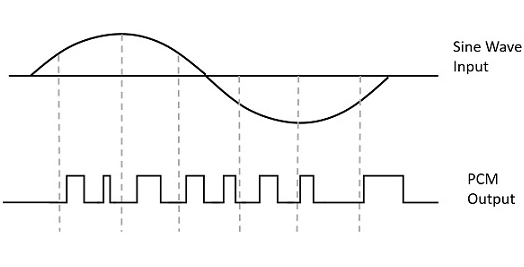 |
Pulse code modulation |
In digital modulation, themodulation technique used is Pulse Code Modulation (PCM). The pulse code modulation is the method of converting an analog signal into a digital signal I.e. 1s and 0s. As the resultant signal is a coded pulse train, this is called as pulse code modulation. |
3) Types of Signals in Modulation
In modulation process, three types of signals are used to transmit information from source to destination. They are:
- Message signal
- Carrier signal
- Modulated signal
In order to help make you better understand these types of signals in modulation, FMUSER has listed what you need about modulation in the following chart, including the types of modulation, the branch names of the modulation as well as the definition of each one of them.

|
Types, Names, and MainCharacteristicsofSignals in Modulation |
|||
|
Types |
Sample graph | Names | Main Characteristics |
|
Modulation Signals |
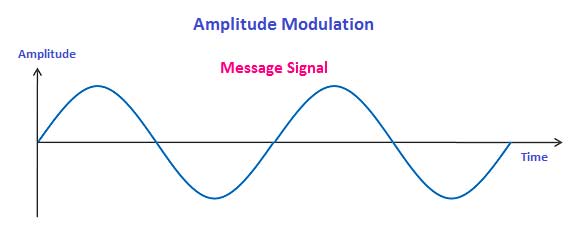 |
Message signal |
The signal whichcontains a message to be transmitted to the destination is called a message signal. The message signal is also known as a modulating signal or baseband signal.The original frequency range of a transmission signal is called baseband signal. The message signal or baseband signal undergoes a process called modulation before it gets transmitted over the communication channel. Hence, the message signal is also known as the modulating signal. |
     |
Carrier signal |
The high energy or high frequency signal which has characteristics like amplitude, frequency, and phase but contains no information is called a carrier signal. It is also simply referred to as a carrier. Carrier signal is used to carry the message signal from transmitter to receiver. The carrier signal is also sometimes referred to as an empty signal. |
|
 |
Modulated signal |
When the message signalis mixed with the carrier signal, a new signal is produced. This new signal is known as a modulated signal. The modulated signal is the combination of the carrier signal and modulating signal. |
|
4) Need of modulation
You may ask, when the baseband signal can be transmitted directly why to use the modulation ? The answer is that the baseband transmission has many limitations which can be overcome using modulation .
- In the process of modulation, the baseband signal is translated i.e., shifted from low frequency to high frequency . This frequency shift is proportional to the frequency of carrier.
- In a carrier communication system, the baseband signal of a low-frequency spectrum is translated to a high frequency spectrum. This is achieved through modulation. The aim of this topic is to explore the reasons for using modulation. Modulation is defined as a process by virtue of which, some characteristic of a high frequency sinusoidal wave is varied in accordance with the instantaneous amplitude of the baseband signal.
- Two signals are involved in the modulation process. The baseband signal and the carrier signal. The baseband signal is to be transmitted to the receiver. The frequency of this signal is generally low. In the modulation process, this baseband signal is called the modulating signal.The waveform of this signal is unpredictable. For example, the waveform of a speech signal is random in nature and cannot be predicted. In this case, the speech signal is the modulating signal.
- The other signal involved with the modulation is a high frequency sinusoidal wave. This signal is called the carrier signal or carrier. The frequency of the carrier signal is always much higher than that of the baseband signal. After modulation, the baseband signal of low frequency is transferred to the high frequency carrier, which carries the information in the form of some variations. After the completion of the modulation process, some characteristic of the carrier is varied such that the resultant variations carry the information.
In the actual application field, the importance of the modulation can be reflected as its functions, modulation is required for;
- High range transmission
- Quality of transmission
- To avoid the overlapping of signals.
Which meanswith the modulation we can, practically speaking:
1. Avoids mixing of signals
2. Increase the range of communication
3. Wireless communication
4. Reduces the effect of noise
5. Reduces height of antenna
① Avoids mixing of signals
One of the basic challenges facing by the communication engineering is transmitting individual messages simultaneously over a single communication channel. A method by which many signals or multiple signals can be combined into one signal and transmitted over a single communication channel is called multiplexing.
We know that the sound frequency range is 20 Hz to 20 KHz. If the multiple baseband sound signals of same frequency range (I.e. 20 Hz to 20 KHz) are combined into one signal and transmitted over a single communication channel without doing modulation, then all the signals get mixed together and the receiver cannot separate them from each other. We can easily overcome this problem by using the modulation technique.
By using modulation, the baseband sound signals of same frequency range (I.e. 20 Hz to 20 KHz) are shifted to different frequency ranges. Therefore, now each signal has its own frequency range within the total bandwidth.
After modulation, the multiple signals having different frequency ranges can be easily transmitted over a single communication channel without any mixing and at the receiver side, they can be easily separated.
② Increase the range of communication
The energy of a wave depends upon its frequency. The greater the frequency of the wave, the greater the energy possessed by it. The baseband audio signals frequency is very low so they cannot be transmitted over large distances. On the other hand, the carrier signal has a high frequency or high energy. Therefore, the carrier signal can travel large distances if radiated directly into space.
The only practical solution to transmit the baseband signal to a large distance is by mixing the low energy baseband signal with the high energy carrier signal. When the low frequency or low energy baseband signal is mixed with the high frequency or high energy carrier signal, the resultant signal frequency will be shifted from low frequency to high frequency. Hence, it becomes possible to transmit information over large distances. Therefore, the range of communication is increased.
③ Wireless communication
In radio communication, the signal is radiated directly into space. The baseband signals have very low frequency range (I.e. 20 Hz to 20 KHz). So it is not possible to radiate baseband signals directly into space because of its poor signal strength. However, by using the modulation technique, the frequency of the baseband signal is shifted from low frequency to high frequency. Therefore, after modulation, the signal can be directly radiated into space.
④ Reduces the effect of noise
Noise is an unwanted signal that enters the communication system via the communication channel and interferes with the transmitted signal.
A message signal cannot travel for a long distance because of its low signal strength. Addition of external noise will further reduce the signal strength of a message signal. So in order to send the message signal to a long distance, we need to increase the signal strength of the message signal. This can be achieved by using a technique called modulation.
In modulation technique, a low energy or low frequency message signal is mixed with the high energy or high frequency carrier signal to produce a new high energy signal which carries information to a long distance without getting affected by the external noise.
⑤ Reduces height of antenna
When the transmission of a signal occurs over free space, the transmitting antenna radiates the signal out and receiving antenna receives it. In order to effectively transmit and receive the signal, the antenna height should be approximately equal to the wavelength of the signal to be transmitted.
Now,

For instance, to radiate an audio signal frequency of 20 kHz directly into space, we would need an antenna height of 15,000 meters.

On the other hand, if the audio signal (20 Hz) has been modulated by a carrier wave of 200 MHz. Then, we would need an antenna height of 1.5 meters.

⑥ For narrow banding of signal:
Usually for range 50Hz-10 kHz we require antenna having the ratio of highest to lowest frequency/ wavelength is 200, which is practically impossible. Modulation converts a wideband signal into a narrow-band signal whose ratio between highest frequency to lowest frequency is approximately one and single antenna will be sufficient to transmit the signal.
Message signals also known as baseband signals are the band of frequencies representing the original signal. This is the signal to be transmitted to the receiver. Frequency of such a signal is usually low. The other signal involved with this is a high-frequency sinusoidal wave. This signal is called the carrier signal. The frequency of carrier signals is almost always higher than that of the baseband signal. The amplitude of the baseband signal is transferred to the high-frequency carrier. Such a higher frequency carrier is able to travel much farther than the baseband signal.
Also read: How to DIY your FM Radio Antenna|Homemade FM Antenna Basics&Tutorials
The amplitude modulation definition is, an amplitude of the carrier signal is proportional to (in accordance with) the amplitude of the input modulating signal. In AM, there is a modulating signal. This is also called an input signal or baseband signal (Speech for example). This is a low-frequency signal as we have seen earlier. There is another high-frequency signal called carrier. The purpose of AM is to translate the low-frequency baseband signal to a higher freq signal using the carrier. As discussed earlier, high-frequency signals can be propagated over longer distances than lower frequency signals.
1) Types of Amplitude Modulation
The different types of amplitude modulations include the following.
- Double sideband-suppressed carrier (DSB-SC) modulation
The transmitted wave consists of only the upper and lower sidebandsBut the channel bandwidth requirement is the same as before.
- Single sideband (SSB) modulation
To translate the spectrum of the modulating signal to a new location in the frequency domain
- Vestigial sideband (VSB) modulation
The required channel bandwidth is slightly in excess of the message bandwidth by an amount equal to the width of the vestigial sideband.
2) Applications of Amplitude Modulation
In broadcasting transmissions over large distances: We use AM is widely in radio communications over long distances in transmissions. Amplitude modulation is used in a variety of applications. Even though it is not as widely used as it was in previous years in its basic format it can nevertheless still be found. Often we use the radio for music and radio uses transmission based on Amplitude Modulation. Also in the air traffic control, amplitude modulation is used in a 2-way communication over the radio for aircraft guidance.
|
Applications of Amplitude Modulation |
|||
| Types |
Sample graph |
Applications | |
|
Broadcast transmissions |
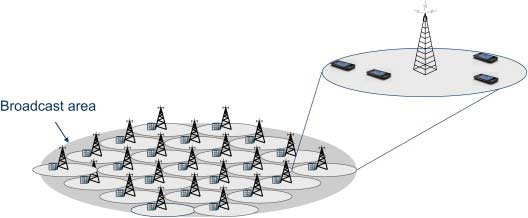
|
AM is still widely used for broadcasting on the long, medium and short wave bands because the radio recivers capable of demodulating amplitude modulation are cheap and simple to manufacture, which means that radio receivers capable of demodulating amplitude modulation are low-cost and easy-manufacturing. Nevertheless many people are moving to high quality forms of transmission like frequency modulation, FM or digital transmissions. |
|
|
Air-band radio |
|
VHF transmissions for many airborne applications still use AM. . It is used for ground to air radio communications, e.g. television standard broadcasting, aids to navigation, telemetering,wo way radio links, radar and, facsimile, etc. |
|
|
Single sideband |
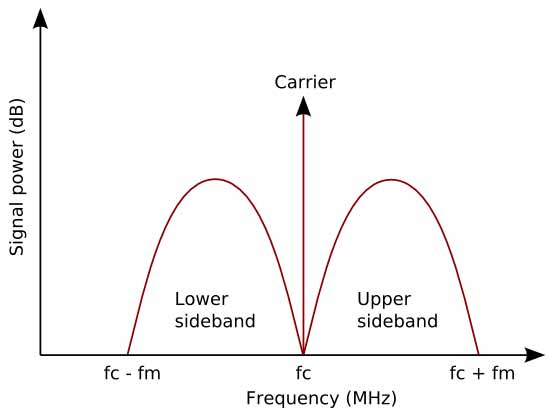 |
Amplitude modulation in the form of single sideband is still used for point to point HF (High frequency) radio links. Using a lower bandwidth and providing more effective use of the transmitted power this form of modulation is still used for many point to point HF links. |
|
|
Quadrature amplitude modulation |
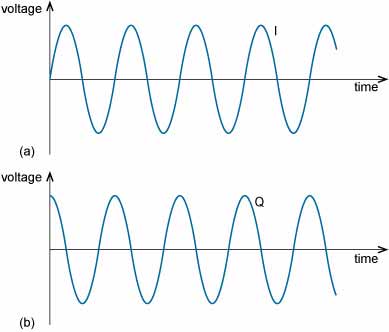 |
AM is widely used for the transmission of data in everything from short range wireless links such as Wi-Fi to cellular telecommunications and much more. Quadrature amplitude modulationis formed by having two carriers out of phase by 90°. |
|
Frequency modulation is a technique or a process of encoding information on a particular signal (analogue or digital) by varying the carrier wave frequency in accordance with the frequency of the modulating signal. As we know, a modulating signal is nothing but information or message that has to be transmitted after being converted into an electronic signal.
Much like in amplitude modulation, frequency modulation also has a similar approach where a carrier signal is modulated by the input signal. However, in the case of FM, the amplitude of the modulated signal is kept or it remains constant.
1) Types of Frequency Modulation
- Frequency Modulation in Communication Systems
There are two different types of frequency modulation used in telecommunications:analog frequency modulationanddigital frequency modulation.
In analog modulation, a continuously varying sine carrier wave modulates the data signal. The three defining properties of a carrier wave -- frequency, amplitude, and phase -- are used to create AM, PM, and Phase Modulation. Digital modulation, categorized as either Frequency Shift Key, Amplitude Shift Key, or Phase Shift Key, functions similarly to analog, however where analog modulation is typically used for AM, FM, and short-wave broadcasting, digital modulation involves transmission of binary signals (0 and 1).
- Frequency Modulation in Vibration Analysis
Vibration analysis is a process for measuring and analyzing the levels and patterns of vibration signals or frequencies of machinery in order to detect abnormal vibration events and evaluate the overall health of machines and their components. Vibration analysis is especially useful with rotating machinery, in which exist fault mechanisms that may cause amplitude and frequency modulation abnormalities. The demodulation process can directly detect these modulation frequencies and is used to recover the information content from the modulated carrier wave.
|
Basic communications system includes these 3 parts |
|
|
Transmitter |
The sub-system that takes the information signal and processes it prior to transmission. The transmitter modulates the information onto a carrier signal, amplifies the signal and broadcasts it over the channel. |
|
Channel |
The medium which transports the modulated signal to the receiver. Air acts as the channel for broadcasts like radio. May also be a wiring system like cable TV or the Internet. |
|
Receiver |
The sub-system that takes in the transmitted signal from the channel and processes it to retrieve the information signal. The receiver must be able to discriminate the signal from other signals which may using the same channel (called tuning), amplify the signal for processing and demodulate (remove the carrier) to retrieve the information. It also then processes the information for reception (for example, broadcast on a loudspeaker). |
| Sample graph |
 |
Also read: What is the Difference between AM and FM?
2) Applications of Frequency Modulation
Frequency Modulation (FM) is a form of modulation in which changes in the carrier wave frequency correspond directly to changes in the baseband signal. FM is considered an analog form of modulation because the baseband signal is typically an analog waveform without discrete, digital values.Summary of the advantages and disadvantages of frequency modulation, FM, detailing why it is used in certain applications and not others.
Frequency modulation (FM) is most commonly used for radio and television broadcast. The FM band is divided between a variety of purposes. Analog television channels 0 through 72 utilize bandwidths between 54 MHz and 825 MHz. In addition, the FM band also includes FM radio, which operates from 88 MHz to 108 MHz. Each radio station utilizes a 38 kHz frequency band to broadcast audio.FM is widely used because of the many advantages of frequency modulation. Although, in the early days of radio communications, these were not exploited because of a lack of understand of how to benefit from FM, once these were understood, its use grew.
Frequecny modulation is widely used in:
|
Applications of Frequency Modulation |
|||
| Types | Sample graph |
Applications |
|
|
FM radio broadcasting |
 |
If we talk about the applications of frequency modulation, it is mostly used in radio broadcasting. It offers a great advantage in radio transmission as it has a larger signal-to-noise ratio. Meaning, it results in low radio frequency interference. This is the main reason that many radio stations use FM to broadcast music over the radio. |
|
|
Radar |
 |
The application in the field of radar distance measurement is: Frequency-modulated continuous-wave radar (FM-CW) – also called continuous-wave frequency-modulated (CWFM) radar – is a short-range measuring radar set capable of determining the distance. |
|
|
Seismic prospecting |
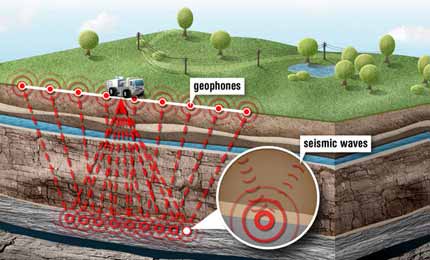 |
Frequency modulation is often used to conduct a modulated seismic survey involves the steps of providing seismic sensors capable of receiving a modulated seismic signal comprised of different frequency signals, transmitting modulated seismic energy information into the earth, and recording indications of reflected and refracted seismic waves sensed by the seismic sensors in response to transmission of the modulated seismic energy information into the earth. |
|
|
Telemetry system |
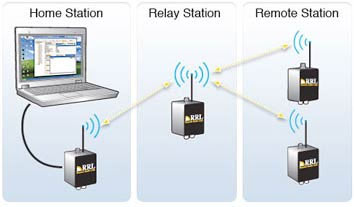 |
In most telemetering systems, modulation is carried out in two stages. First, the signal modulates a subcarrier (a radio-frequency wave the frequency of which is below that of the final carrier), and then the modulated subcarrier, in turn, modulates the output carrier. Frequency modulation is used in many of these systems to impress the telemetry information on the subcarrier. If frequency-division multiplexing is used to combine a group of these frequency-modulated subcarrier channels, the system is known as an FM/FM system. |
|
|
EEG monitoring |
 |
By setting frequency modulated (FM) models to noninvasively monitor brain activity, the electroencephalogram (EEG) remains the most reliable tool in the diagnosis of neonatal seizures as well as seizure detection and classification through an efficient signal processing methods. |
|
|
Two-way radio systems |
 |
FM is also used for a variety of two-way radio communication systems. Whether for fixed or mobile radio communication systems or for use in portable applications, FM is widely used at VHF and above. |
|
|
Sound synthesis |
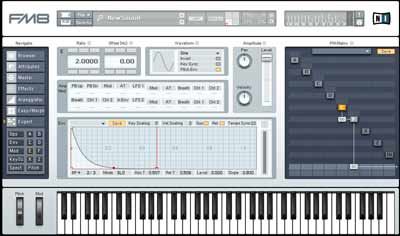 |
Frequency modulation synthesis (or FM synthesis) is a form of sound synthesis whereby the frequency of a waveform is changed by modulating its frequency with a modulator. The frequency of an oscillator is altered "in accordance with the amplitude of a modulating signal. FM synthesis can create both harmonic and inharmonic sounds. To synthesize harmonic sounds, the modulating signal must have a harmonic relationship to the original carrier signal. As the amount of frequency modulation increases, the sound grows progressively complex. Through the use of modulators with frequencies that are non-integer multiples of the carrier signal (i.e. inharmonic), inharmonic bell-like and percussive spectra can be created. |
|
|
Magnetic tape-recording systems |
 |
FM is also used at intermediate frequencies by analog VCR systems (including VHS) to record the luminance (black and white) portions of the video signal. |
|
|
Video-transmission systems |
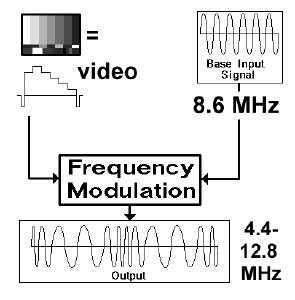 |
Video modulation is a strategy of transmitting video signal in the field of radio modulation and television technology. This strategy enables the video signal to be transmitted more efficiently through long distances. In general, video modulation means that a higher frequency carrier wave is modified according to the original video signal. In this way, carrier wave contains the information in the video signal. Then, the carrier will "carry" the information in the form of radio frequency (RF) signal. When carrier reaches its destination, the video signal is extracted from the carrier by decoding. In other words, the video signal is first combined with a higher frequency carrier wave so that carrier wave contains the information in video signal. The combined signal is called radio-frequency signal. At the end of this transmitting system, the RF signals stream from a light sensor and hence, the receivers can obtain the initial data in the original video signal. |
|
|
Radio and television broadcasts |
 |
Frequency modulation (FM) is most commonly used for radio and television broadcasts, this helps in a larger signal to noise ratio. The FM band is divided into a variety of purposes. Analog television channels 0 through 72 utilize bandwidths between 54 MHz and 825 MHz. In addition, the FM band also includes FM radio, which operates from 88 MHz to 108 MHz. Each radio station utilizes a 38 kHz frequency band to broadcast audio. |
|
4. What are the Advantages and Disadvantages of Amplitude Modulation?
1) The Advantages of Amplitude Modulation (AM)
The advantages of the amplitude modulation includes:
*What are the advantages of Amplitude Modulation?*
|
The advantages of AM |
Description |
|
High Controllability |
Amplitude modulation is so simple to implement. Demodulation of AM signals can be done using simple circuits consisting of diodes which means by using a circuit with only fewer components it can be demodulated. |
|
Unique Practicality |
Amplitude modulation is easily obtainable and available. AM transmtiter are less complex and no specialized components are needed |
|
Super Economy |
Amplitude modulation is quite-low-cost and economical. AM receivers are very cheap,AM transmitters are cheap. You won't be overcharged because AM receiver and AM transmitter doesn’t require any specialized components. |
|
High Effectivity |
Amplitude modulation is highly-beneficial. AM signals are reflected back to earth from the ionosphere layer. Due to this fact, AM signals can reach far places that are thousands of miles from the source. Hence AM radio has coverage wider compare to FM radio. What's more, with a long distance its waves (AM waves) can travel, and low bandwidth its wave has, amplitude modulation still exists with great market vitality. |
Conclusion:
1. The Amplitude modulation is economical as well as easily obtainable.
2. It is so simple to implement, and by using a circuit with fewer components it can be demodulated.
3. The AM receivers are inexpensive because it doesn’t require any specialized components.
2) The disadvantages of Amplitude Modulation (AM)
The advantages of the amplitude modulation includes:
*What are the disadvantages of Amplitude Modulation?*
| The disadvantages of AM | Description |
|
Inefficient bandwidth usage |
Weak AM signals have a low magnitude compare to strong signals. This requires AM receiver to have circuitry to compensate for the signal level difference. Namely, the amplitude modulation signal is not efficient in terms of its power usage and its' power wastage takes place in DSB-FC (Double Side Band - Full Carrier ) transmission. This modulation uses amplitude-frequency several times to modulate the signal by a carrier signal, namely, it requires more than twice the amplitude-frequency to modulate the signal with a carrier, which declines the original signal quality on the receiving end. For 100% modulation, the power carried by AM waves is 33.3%. The power carried by the AM wave decreases with the decrease in the extent of modulation.
This means it may cause trouble in the signal quality. As a result, the efficiency of such a system is very low as it consumes a lot of power for modulations and It requires a bandwidth that is equivalent to that of the highest audio frequency hence it is not efficient in terms of its use of bandwidth. |
|
Poor anti-noise interference ability |
The most natural as well as man-made radio noise are of AM type. AM detectors are sensitive to noise, this means AM systems are susceptible to the generation of highly noticeable noise interference, and AM receivers do not have any means to reject this kind of noise. This limits the applications of Amplitude Modulation to VHF, radios, & applicable one to one communication only |
|
Low sound fidelity |
Reproduction is not high fidelity. For high-fidelity (stereo) transmission bandwidth should be 40000 Hz. To avoid interference the actual bandwidth used by AM transmission is 10000 Hz |
Conclusion:
1. The efficiency of amplitude modulation is very low because it uses a lot of power.
2. The Amplitude modulation uses amplitude-frequency several times to modulate the signal by a carrier signal.
3. The Amplitude modulation declines the original signal quality on the receiving end & causes troubles in the signal quality.
4. Amplitude modulation systems are susceptible to the generation of noise generation.
5. The applications of amplitude modulation limits to VHF, radios, & applicable one to one communication only.
5. Which is better: Amplitude Modulation or Frequency Modulation?
There are many advantages and disadvantages to the use of amplitude modulation and frequency modulation. This has meant that each one of them have been widely used for many years, and will remain in use for many years, but which modulation is better, is it amplitude modulation or frequency modulation? What are the difference between the the advantages and disadvantages of AM and FM? The following charts may help you find out the answers...
1) What are the Advantages and Disadvantages of FM over AM?
*What are the disadvantages of FM over AM?*
Comparison
Description
In terms of noise resistance
One of the main advantages of frequency modulation that has been utilized by the broadcasting industry is the reduction in noise.
The amplitude of the FM wave is constant. It is thus independent of the modulation depth. whereas in AM, modulation depth governs the transmitted power. This permits the use of low-level modulation in FM transmitter and the use of efficient class C amplifiers in all stages following the modulator. Further, since all amplifiers handle constant power, the average power handled equals the peak power. In AM transmitter the maximum power is four times the average power.
In FM, recovered voice depends on the frequency and not amplitude. Hence the effects of noise are minimized in FM. As most noise is amplitude-based, this can be removed by running the signal through a limiter so that only frequency variations appear. This is provided that the signal level is sufficiently high to allow the signal to be limited.
In terms of sound quality
FM bandwidth covers all the frequency range which humans can hear. Hence FM radio has a better quality of sound in comparison with AM radio. Standard Frequency Allocations provide a guard band between commercial FM stations. Due to this, there is less adjacent-channel interference than in AM. FM broadcasts operate in the upper VHF and UHF frequency ranges at which there happens to be less noise than in the MF and HF ranges occupied by AM broadcasts.
In FM receivers, the noise can be reduced by increasing the frequency deviation, and hence FM reception is immune to noise as compared to AM reception. FM receivers may be fitted with amplitude limiters to remove the amplitude variations caused by noise. This makes FM reception more immune to noise than AM reception. It is possible to reduce noise still further by increasing the frequency-deviation. This is a feature that AM does not have because it is not possible to exceed 100 percent modulation without causing severe distortion.
In the same way that amplitude noise can be removed, so too can any signal variations. FM transmission can be used for stereo sound transmission due to a large number of sidebands. This means that one of the advantages of frequency modulation is that it does not suffer audio amplitude variations as the signal level varies, and it makes FM ideal for use in mobile applications where signal levels constantly vary. This is provided that the signal level is sufficiently high to allow the signal to be limited. So, FM is resilient to signal strength variations
As only frequency changes are required to be carried, any amplifiers in the transmitter do not need to be linear. FM transmitters are highly efficient than AM transmitters as in Am transmission most of the power goes waste in the transmitted carrier. Namely, FM requires non -linear amplifiers eg class C, etc instead of linear amplifiers, this means that transmitter efficiency levels will be higher-linear amplifiers are inherently inefficient.
There are many advantages to the use of frequency modulation. This has meant that it has been widely used for many years, and will remain in use for many years.
Conclusion:
1. In FM receivers the noise can be reduced by increasing the frequency deviation and hence FM reception is immune to noise as compared to AM reception, thus FM radio has better sound quality than AM radio
2. FM is less prone to some kinds of interference, bear in mind that almost all-natural and man-made interference is seen as amplitude changes.
3. FM requires no linear amplification stages and comes with less radiated power.
4. FM is easier to synthesize frequency shifts than amplitude shifts making digital modulation simpler.
5. FM allows simpler circuits to be used for frequency tracking (AFC) at the receiver.
6. FM transmitter is highly efficient than AM transmitter as in AM transmission most of the power goes waste in the transmitted carrier.
7. FM transmission can be used for the stereo sound transmission due to a large number of sidebands
8. FM signals has been improved to noise ratio (about 25dB) with regard to man-made interference.
9. Interferences will be largely reduced geographically between neighboring FM radio stations.
10. Service areas for given transmitter power of the FM are well defined.
2) What are the Disadvantages of FM?
There are a number of disadvantages to the use of frequency modulation. Some are can be overcome quite easily, but others may mean that another modulation format is more suitable. The disadvantages of frequency modulation include the following:
*What are the disadvantages of FM over AM?*
The FM receivers and the FM transmitters are much more complicated than AM receivers and AM transmitters. Besides, FM requires a more complicated demodulator. The transmitting and receiving equipment are very complex in FM. For example, the FM demodulator is a little more complicated, and hence slightly more costly than the very simple diode detectors used for AM. Also requiring a tuned circuit adds cost. However, this is only an issue for the very low-cost broadcast receiver market.
Comparison
Description
In terms of coverage
At higher frequencies, FM modulated signals pass through the ionosphere and do not get reflected. Hence FM has lesser coverage compare to AM signal. Additionally, the area of reception for FM transmission is much smaller than that for AM transmission as the FM reception is limited to Line-of-sight propagation (L-O-S).
In terms of bandwidth needing
The bandwidth in FM transmission is 10 times as large as that needed in AM transmission. Hence wider frequency channel is required in FM transmission (as much as 20 times as much). For example, a much wider channel typically 200 kHz is required in FM as against only 10 kHz in AM broadcast. This forms a serious limitation of FM.
In terms of hardware equipment options
In terms of data spectral efficiency
Compared with FM, some other modes have higher data spectral efficiency. Some phase modulation and quadrature amplitude modulation formats have higher spectral efficiency for data transmission than frequency shift keying, a form of frequency modulation. As a result, most data transmission systems use PSK and QAM.
In terms of sidebands limitation
Sidebands of FM transmission extend to infinity on either side. The sidebands for an FM transmission theoretically extend out to infinity. To limit the bandwidth of the transmission, filters are used, and these introduce some distortion of the signal.
Conclusion:
1. The equipment needed for FM and AM systems is different. The equipment cost of an FM channel is more since the equipment is much more complex and involves complicated circuitry. As a result FM systems are costlier than AM systems.2. FM systems work using a line of sight propagation whereas AM systems use skywave propagation. Consequently, the receiving area of an FM system is much smaller than that of an AM system. The antennae for FM systems need to be close by whereas AM systems can communicate with other systems throughout the world by reflecting signals off the ionosphere.
3. In an FM system, there is an infinite number of sidebands resulting in a theoretical bandwidth of an FM signal being infinite. This bandwidth is limited by Carson’s rule but it is still much larger than that of an AM system. In an AM system, the bandwidth is only twice the modulation frequency. This is another reason why FM systems are costlier than AM systems.
There are many advantages to using frequency modulation - it is still widely used for many broadcast and radio communications applications. However, with more systems using digital formats, phase and quadrature amplitude modulation formats are on the increase. Nevertheless, the advantages of frequency modulation mean that it is an ideal format for many analog applications.
Also read: What is QAM: quadrature amplitude modulation
Free RF knowledge supplement:
*What are the differences between AM and FM?*
| AM |
FM |
||
| Stands for |
Amplitude Modulation |
Stands for |
Frequency Modulation |
|
Origin |
AM method of audio transmission was first successfully carried out in the mid 1870s.
|
Origin |
FM radio was developed in the United states in the 1930s, mainly by Edwin Armstrong.
|
|
Modulating differences |
In AM, a radio wave known as the "carrier" or "carrier wave" is modulated in amplitude by the signal that is to be transmitted. The frequency and phase remain the same. |
Modulating differences |
In FM, a radio wave known as the "carrier" or "carrier wave" is modulated in frequency by the signal that is to be transmitted. The amplitude and phase remain the same. |
|
Pros and cons |
AM has poorer sound quality compared with FM, but is cheaper and can be transmitted over long distances. It has a lower bandwidth so it can have more stations available in any frequency range. |
Pros and cons |
FM is less prone to interference than AM. However, FM signals are impacted by physical barriers. FM has better sound quality due to higher bandwidth. |
|
Bandwidth requirements |
Twice the highest modulating frequency. In AM radio broadcasting, the modulating signal has bandwidth of 15kHz, and hence the bandwidth of an amplitude-modulated signal is 30kHz. |
Bandwidth requirements |
Twice the sum of the modulating signal frequency and the frequency deviation.
If the frequency deviation is 75kHz and the modulating signal frequency is 15kHz, the bandwidth required is 180kHz.
|
|
Frequency range |
AM radio ranges from 535 to 1705 KHz (OR) Up to 1200 bits per second. |
Frequency Range |
FM radio ranges in a higher spectrum from 88 to 108 MHz. (OR) 1200 to 2400 bits per second. |
|
Zero crossing in modulated signal |
Equidistant |
Zero crossing in modulated signal |
Not equidistant |
|
Complexity |
Transmitter and receiver are simple but syncronization is needed in case of SSBSC AM carrier. |
Complexity |
Tranmitter and reciver are more complex as variation of modulating signal has to beconverted and detected from corresponding variation in frequencies.(i.e. voltage to frequency and frequency to voltage conversion has to be done). |
|
Noise |
AM is more susceptible to noise because noise affects amplitude, which is where information is "stored" in an AM signal. |
Noise |
FM is less susceptible to noise because information in an FM signal is transmitted through varying the frequency, and not the amplitude. |
Also read:
16 QAM modulation vs 64 QAM modulation vs 256 QAM modulation
512 QAM vs 1024 QAM vs 2048 QAM vs 4096 QAM modulation types
6. Which is better: AM Radio or FM Radio?
1) What are the Advantages and Disadvantages of AM Radio and FM Radio?
As one of the world's most well-known broadcast equipment manufacturers and manufacturers, FMUSER can give you professional advice. Before you wholesale AM radios or wholesale FM radios, you may wish to see the pros and cons AM radios and FM radios, well, here's a chart provided by FMUSER's RF technician, it might help you make your best choice on how to choose between AM radio and FM radio! By the way, the following content will help you fundamentally build up the cognition to one of the most important parts of RF radio technology.
*How to choose between AM radio and FM radio?*
| AM Radio | FM Radio | ||
|
Advantages |
1. Travels farther at night 2. Most stations have higher wattage outputs 3. Where the real music was first played and where it still sounds good. |
Advantages |
1. It's in stereo 2. The signal is strong no matter what time of day 3. More variety of music on more stations |
| Disadvantages |
1. Sometimes a weak signal around power lines 2. Lightning makes the signal scratchy 3. The signal can be off a few kilowatts during sunrise and sunset times. |
Disadvantages |
1. A lot of trash talk and untasteful music 2. Not much (if any) news coverage 3. Hardly ever a mention of the call sign or (real) dial location. |
2) What Are Radio Waves?
Radio waves are a type of electromagnetic radiation best-known for their use in communication technologies, such as television, mobile phones and radios. These devices receive radio waves and convert them to mechanical vibrations in the speaker to create sound waves.
The radio-frequency spectrum is a relatively small part of the electromagnetic (EM) spectrum. The EM spectrum is generally divided into seven regions in order of decreasing wavelength and increasing energy and frequency
Radio waves are a category of electromagnetic radiation in the electromagnetic spectrum with wavelengths that are longer than infrared light. The frequency of radio waves ranges from 3 kHz to 300 GHz. Just like all other types of electromagnetic waves, they travel at the speed of light in a vacuum.
They are most commonly used in mobile radio communication, computer networks, communication satellites, navigation, radar and broadcasting. The International Telecommunications Union is the authority that regulates the use of radio waves. It has stipulations to control users in the pursuit to avoid interference. It works in coordination with other international and national authorities to ensure the adherence to safe practices.
Radio waves were discovered in 1867 by James Clerk Maxwell. Today, studies have enhanced what humans understand about radio waves. Learning properties such as polarization, reflection, refraction, diffraction and absorption has enabled scientists to develop useful technology based on the phenomena.
3) What are the Bands of Radio Waves?
The National Telecommunications and Information Administration generally divides the radio spectrum into nine bands:
|
Band |
Frequency Range |
Wavelength Range |
|
Extremely Low Frequency (ELF) |
<3 kHz |
>100 KM |
|
Very Low Frequency (VLF) |
3 to 30 kHz |
10 to 100 KM |
|
Low Frequency (LF) |
30 to 300 kHz |
1 m to 10 km |
|
Medium Frequency (MF) |
300 kHz to 3 MHz |
100 m to 1 km |
|
High Frequency (HF) |
3 to 30 MHz |
10 to 100 m |
|
Very High Frequency (VHF) |
30 to 300 MHz |
1 to 10 m |
|
Ultra High Frequency (UHF) |
300 MHz to 3 GHz |
10 cm to 1 m |
|
Super High Frequency (SHF) |
3 to 30 GHz |
1 to 1 cm |
|
Extremely High Frequency (EHF) |
30 to 300 GHz |
1 mm to 1 cm |
3) Types of Radio Waves and Their Advantages and Disadvantages
In general, the longer the wavelength, the more easily the waves can penetrate built structures, water and the Earth. The first around-the-world communication (short wave radio) used the ionosphere to reflect signals over the horizon. Modern satellite based systems use very short wavelength signals, which include microwaves. However, how many types of waves are there in RF field? What are the advantages and disadvantages of each one of them? Here's chart that lists the advantages and disadvantages of 3 main types of radio waves,
|
Types of waves |
Advantages |
Disadvantages |
|
Microwaves (very short wave length radio waves) |
1. Pass through the ionosphere, so are suitable for satellite to Earth transmission. 2. Can be modified to carry many signals at one time, including data, television pictures and voice messages. |
1. Need special aerials to receive them. 2. Absorbed very easily by natural, e.g. rain, and made objects, e.g. concrete. They are also absorbed by living tissue and may cause harm by their cooking effect. |
|
Radio waves |
1. Some are reflected off the ionosphere, so can travel around the Earth.
2. Can carry a message instantaneously over a wide area.3. Aerials to receive them are simpler than for microwaves. |
The range of frequencies that can be accessed by existing technology is limited, so there is a lot of competition amongst companies for the use of the frequencies. |
|
Both microwaves and radio waves |
Wires are not needed as they travel through air, thus, a cheaper form of communication. |
Travel in a straight line, so repeater stations may be needed. |
Also read: How to Eliminate Noise on AM and FM Receiver?
Note: One of the disadvantages of radio waves is that they cannot transmit a lot of data simultaneously because they're low frequency. In addition, continued exposure to large amounts of radio waves can cause health disorders like leukemia and cancer. Despite these setbacks, technicians have effectively achieved enormous breakthroughs. For example, astronauts use radio waves to transmit information from space to Earth and vice versa.
The following table identifies some communication technologies that use energies from the electromagnetic spectrum for communication purposes.
|
Communication technology |
Description |
Part of the electromagnetic spectrum used |
|
Optical fibres |
Replacing copper cables in coaxial cables and phone lines as they last longer and carry 46 times more conversations than copper cables |
Visible light |
|
Remote control communication |
Remote controls for a variety of electrical devices, such as TV, video, garage doors and infra-red computer systems Part of the electromagnetic spectrum used |
Infra-red |
|
Satellite technologies |
This technology mostly makes use of frequencies in the super high frequency (SHF) range and the extra high frequency (EHF) range. |
Microwaves |
|
Mobile phone networks |
These use a combination of systems. Electromagnetic radiation (EMR) is used to communicate between individual mobile phones and each local mobile exchange. Exchange networks communicate using land lines (coaxial or optic fibre). |
Microwaves
|
|
TV broadcasting |
TV stations transmit in the very high frequency (VHF) range and the ultra high frequency (UHF) range. |
Shortwave radio; frequencies ranging from 1 Ghz – 150 Mhz. |
|
Radio broadcasting |
1. Radio is used for a broad range of technologies including AM and FM broadcasting and amateur radio. 2. Radio dial indicated frequency range for FM: 88 – 108 megahertz. 3. Radio dial indicated frequency range for AM: 540 – 1600 kilohertz. |
Shortwave and longwave radio; frequencies ranging from 10 Mhz – 1 Mhz. |
7. Frequently Ask Question on RF Technology
Question:
Which of the following is not a part of the generalized communication system
a. Receiver
b. Channel
c. Transmitter
d. Rectifier
Answer:
d. Receiver, Channel, and Transmitter are parts of the communication system.
Question:
What is AM radio used for?
Answer:
In many countries, AM radio stations are known as "mediumwave" stations. They are also sometimes referred to as "standard broadcast stations" because AM was the first form used to transmit broadcast radio signals to the public.
Question:
Why does AM radio not work at night?
Answer:
Most AM radio stations are required by the FCC's rules to reduce their power or cease operating at night in order to avoid interference to other AM stations. ... However, during nighttime hours the AM signals can travel over hundreds of miles by reflection from the ionosphere, a phenomenon called "skywave" propagation
Question:
Will AM radio go away?
Answer:
Seems so retro, but it is still useful. Nevertheless, AM radio has been in decline for years, with many AM stations going out of business each year. ... Nevertheless, AM radio has been in decline for years, with many AM stations going out of business each year. Now there are only 4,684 left as of the end of 2015.
Question:
How do I know if my radio is digital or analog?
Answer:
A standard analog radio is going to decrease in signal the closer you get towards its maximum range, at which point all you hear is white noise. On the other hand, a digital radio is going to remain much more consistent in sound quality regardless of distance to or from the maximum range.
Question:
What is difference between AM and FM?
Answer:
The difference is in how the carrier wave is modulated, or altered. With AM radio, the amplitude, or overall strength, of the signal is varied to incorporate the sound information. With FM, the frequency (the number of times each second that the current changes direction) of the carrier signal is varied.
Question:
Why carrier waves are of higher frequency compared to modulating signal?
Answer:
1. High-frequency carrier wave, effectively reduces the size of antenna which increases transmission range.
2. Converts wideband signal into a narrowband signal which can easily be recovered at the receiving end.
Question:
Why we need modulation?
Answer:
1. to transmit the low-frequency signal to longer distance.
2. to reduce the length of the antenna.
3. power radiated by the antenna will be high for high frequency (small wavelength).
4. avoid the overlapping of modulating signals.
Question:
Why is the amplitude of the modulating signal kept less than the amplitude of the carrier wave?
Answer:
To avoid the overmodulation. Typically in overmodulation, the negative half cycle of the modulating signal will be distorted.
Sharing is caring!
Also read
How To Load/Add M3U/M3U8 IPTV Playlists Manually On Supported Devices
What is Low Pass Filter and how to build a Low Pass Filter?
What is VSWR and how to measure VSWR?

